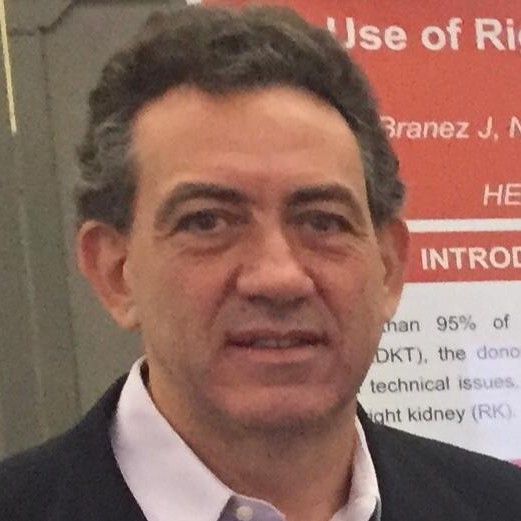Ipsilateral simultaneous pancreas-kidney transplantation with concomitant reperfusion of both grafts versus contralateral SPK transplantation: a single-center analysis of 168 cases
Marcelo Perosa 1, Juan Branez1, Fernanda Danziere1, Aline M. Rocha1, Adriana B. Bortoluzzo2, Maria K. Venezuela2, Ana C. Vidigal1.
1Department of Abdominal Organ Transplantation, Leforte Hospital, São Paulo, Brazil; 2Statistics and Data Science, Brazil, INSPER Institute of Education and Research, São Paulo, Brazil
Introduction: Ipsilateral simultaneous pancreas-kidney transplantation(iSPK) is an attractive surgical strategy searching to reduce operative time and preserve the left iliac fossa for an eventual future transplant. Traditionally, pancreas is placed and reperfused first followed by kidney transplant. The aim of the study was to compare a technical variant of iSPK(v-iSPK) with concomitant reperfusion of both pancreas and kidney grafts to the standard contralateral SPK(cSPK).
Methods: A retrospective analysis was performed of 42 v-iSPK and 117 cSPK from 2018 to 2022. There was also a small group(n=9) of iSPK without concomitant reperfusion(iSPKw/o) for comparison of some specific variables. The decision for graft placement was made during the procedure and based on physical characteristics both of recipient(dimension of pelvis, quality of vessels) and of donor pancreas and kidney. In v-iSPK pancreas was firstly reperfused and after a few minutes for hemostasis, kidney was soon reperfused. Donor and recipient data, surgical and cold ischemia time(CIT), delta time between kidney and pancreas CIT , surgical complications, reoperations and patient and graft survival were compared between the 2 groups.
Results: Donor age(28.5x28.3) and KDPI(26.2x23.8), recipient age(36.5x35.8), race and gender were similar between v-iSPK and cSPK, respectively. Cerebrovascular event as cause of donor death (33.3% x 25.6%, p=0.45) and rate of preemptive SPK(4.8% x 2.6%, p=0.85) were also similar between v-iSPK and cSPK groups. The operative time was shorter(312 x 329min, p= 0.05 ) while pancreas CIT was higher(8.7 x 7.8 hours,p<0.001) and kidney CIT was lower (8.8 x 9.8 hours,p<0.001 ) for v-iSPK. Delta time between kidney and pancreas CIT was significantly inferior in v-iSPK compared to iSPKw/o and cSPK(6 x 105.2 x 121.2 min, respectively, p<0.001). Peak amylase(UI/ml) (231x167x263,p=0.33),peak lipase (204x117x196,p=0.25), peak drain amylase(1164x725x1191,p=0.31), 7-day amylase(137x77x117,p=0.20) and 7-day lipase(87x74x81,p=0.44) were similar among v-iSPK, iSPKw/o and SPK,respectively.The rate of kidney DGF (52.4% x 41.9%,p=0.73) and hospital stay(8.5 x 8.2 days,p=0.65) were similar between v-iSPK and cSPK. There was a tendency of higher 1-year patient (90.5% x 79.5%,p=0.17) and 1-year death censored pancreas(88.1% x 73.7%,p=0.08), similar kidney(92.3% x 87.5%,p=0.60) survival between v-iSPK and cSPK. Pancreas technical failure (2.3% x 12.8%, p=0.01) was lower for iSPK and the need of blood transfusion(11.9% x 16.2%, p=0.67) and rate of reoperations( 19% x 18.8%, p=1.0) were similar between the groups.
Conclusion: v-iSPK is a new variant technique and seems to be as safe as the standard cSPK. The attractive of this new technique is to facilitate the implantation of the ipsilateral kidney graft with a still empty pancreas graft and can shorten surgical time and the time-interval between pancreas and kidney reperfusion in addition to reduce pancreas technical failure.

right-click to download
